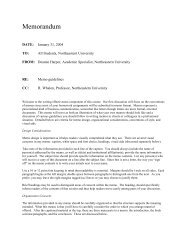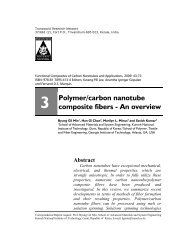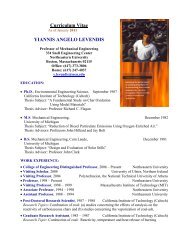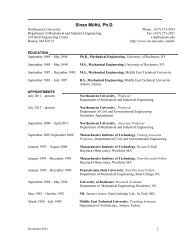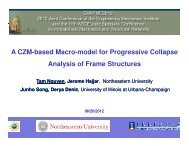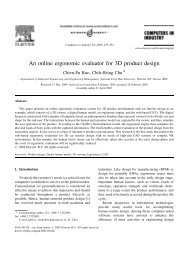You also want an ePaper? Increase the reach of your titles
YUMPU automatically turns print PDFs into web optimized ePapers that Google loves.
simplified versions of these formulas are shown. The equations are<br />
functions of the properties of the headed steel anchors, including<br />
height, shank diameter, <strong>and</strong> concrete strength. The proposed<br />
formulas have been calibrated using a least squares technique,<br />
constraining the average test-to-predicted ratio to equal 1.0 for<br />
all 114 tests failing in the concrete (Fig. 5). The statistical values<br />
for optimized formulas <strong>and</strong> then their corresponding simplified<br />
formulas developed to predict concrete failures of anchors loaded<br />
in shear in composite construction are shown in Table 7.<br />
Proposals 1 <strong>and</strong> 2 have the same form as the current formula<br />
of AISC <strong>and</strong> EC-4, without distinguishing the concrete weight.<br />
Proposal 3 takes into account the stud height, similar to PCI<br />
6th Edition <strong>and</strong> ACI 318-08. Proposal 4 takes into account<br />
the concrete weight (λ), with the result being similar to one<br />
�proposed by Anderson <strong>and</strong> Meinheit [4]. The coefficient λ =<br />
f<br />
′<br />
�<br />
1<br />
≤ 1.0 (in psi) or λ =<br />
≤ 1.0<br />
c,sp<br />
6.7<br />
� 1<br />
√f ′<br />
c<br />
L. Pallarés, J.F. <strong>Hajjar</strong> / Journal of Constructional Steel Research 66 (2010) 198–212 205<br />
Fig. 3. Steel failure formulas in comparison with steel failure in tests.<br />
� f ′<br />
c,sp<br />
0.046<br />
√<br />
f<br />
′<br />
c /0.0069<br />
(in MPa) is a lightweight concrete factor. It can be computed<br />
following either ACI 318-08 or PCI 6th Edition. If the value<br />
of the splitting tensile strength f ′<br />
c,sp is not known, λ equals<br />
0.85 for s<strong>and</strong>–lightweight concrete <strong>and</strong> 0.75 for all-lightweight<br />
concrete. Lightweight concrete according to ACI 318-08 is concrete<br />
containing lightweight aggregate <strong>and</strong> having a density between<br />
90 lb/ft 3 (1440 kg/m 3 ) <strong>and</strong> 115 lb/ft 3 (1840 kg/m 3 ).<br />
Table 7 shows the resistance factors (φ) for reliability indices<br />
of 3 <strong>and</strong> 4 for the tests that failed by the concrete. It can be<br />
seen that all four proposals result in similar resistance factors,<br />
equaling approximately 0.60 for a reliability index of 4 <strong>and</strong> 0.70<br />
for a reliability index of 3.<br />
7. Headed steel stud shear strength for hef /d > 4.5<br />
From the earliest tests carried out by Viest [7], it has been seen<br />
that hef /d is a significant parameter that often delineates the type<br />
of failure that occurs in tests that do not have free edge conditions.<br />
In the tests by Viest [7], for example, the failure normally occurred<br />
in the steel stud when hef /d was larger than 4.53. Driscoll <strong>and</strong><br />
Slutter [8] observed that, if h/d was greater than 4.2, they could<br />
develop all the strength in tension (i.e., AsFu) rather than shear, <strong>and</strong><br />
the tensile strength then determined the ultimate strength of the<br />
studs in their push-out tests. It was further noted that, for studs<br />
shorter than h/d = 4.2, the strength must be reduced because of<br />
the possibility of the ultimate strength being reduced by fracture<br />
of the concrete. Ollgaard et al. [15] tested studs with an effective<br />
embedment depth of 3.50 <strong>and</strong> 4.20. They indicated that in many<br />
tests both steel <strong>and</strong> concrete failures were observed in the same<br />
specimen.<br />
A summary of failures found in the tests in the database<br />
classified as having studs that are greater than or less than a given<br />
hef /d ratio (including ratios of 4.00, 4.50, 5.50, <strong>and</strong> 6.50) is given<br />
in Table 8. AISC [30] states that headed steel studs shall not be<br />
less than four stud diameters in length after installation <strong>and</strong> EC-<br />
4 applies a reduction factor on the stud strength for ratios of h/d<br />
between 3 <strong>and</strong> 4. Recognizing the h/d limitation in AISC [30] <strong>and</strong><br />
assuming that h is a few percent larger than hef to account for the<br />
depth of the stud head, it can be reasoned that for a headed stud<br />
whose h/d value is right at the limit, approximately 73% of the<br />
failures are likely to occur in the steel. In contrast, 81% of the tests<br />
having a ratio hef /d larger than 4.50 failed in the steel, <strong>and</strong> 91%<br />
failed in the steel for hef /d larger than 5.50.<br />
Based on these results, if the minimum h/d ratio limit of 4 in<br />
AISC [30] is recommended for increase to 5 (i.e., hef /d equaling<br />
4.5 for a 3/4 in (19 mm) diameter headed stud having a 3/8<br />
in (9.5 mm) depth of the head), 81% of the 224 tests with ratios<br />
larger than this limit failed in the steel. In order to predict the<br />
failure of the remaining 19% of the tests that failed in the concrete,<br />
one of the proposed formulas in the prior section could be used,<br />
taking the minimum value of steel <strong>and</strong> concrete failures. However,<br />
as discussed below, checking the steel formula alone may be<br />
adequate for this minimum ratio of hef /d.<br />
The required resistance factor for headed studs with hef /d ratios<br />
larger than 4 <strong>and</strong> 4.5 is presented in Table 9. Fig. 5 then plots the<br />
test-to-predicted ratios, separating tests based on their value of<br />
hef /d. Also, in these plots, both the measured material strengths



